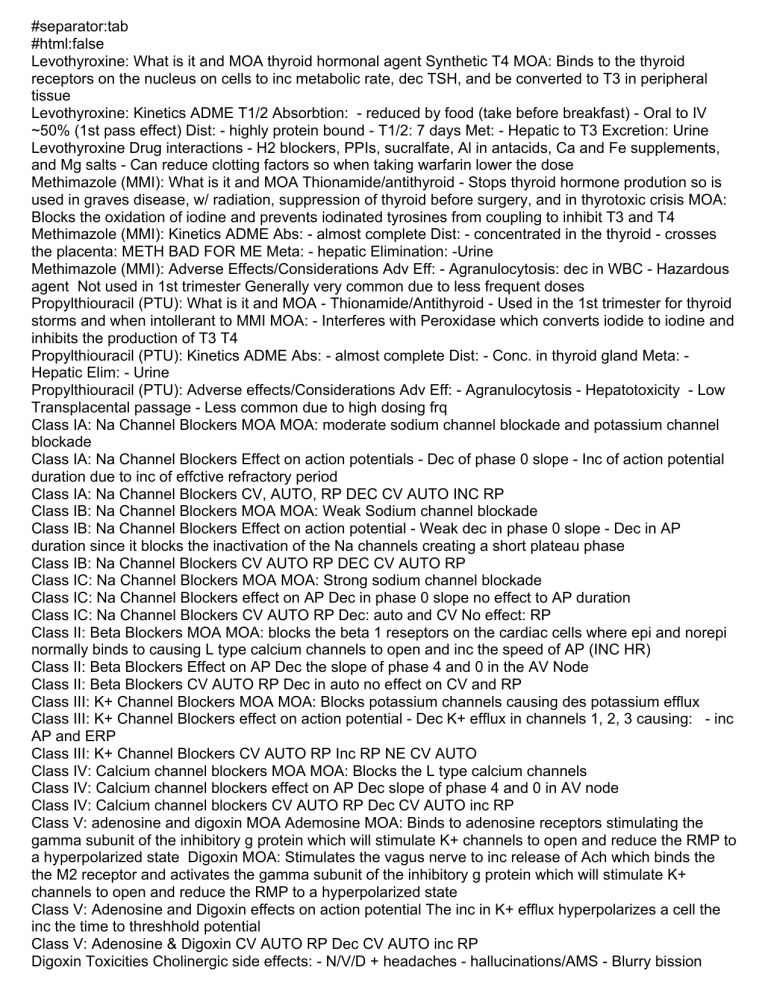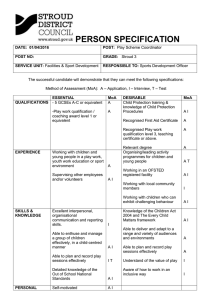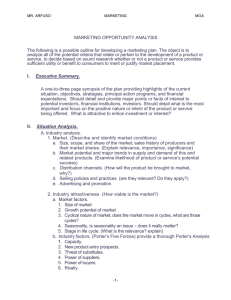
#separator:tab #html:false Levothyroxine: What is it and MOA thyroid hormonal agent Synthetic T4 MOA: Binds to the thyroid receptors on the nucleus on cells to inc metabolic rate, dec TSH, and be converted to T3 in peripheral tissue Levothyroxine: Kinetics ADME T1/2 Absorbtion: - reduced by food (take before breakfast) - Oral to IV ~50% (1st pass effect) Dist: - highly protein bound - T1/2: 7 days Met: - Hepatic to T3 Excretion: Urine Levothyroxine Drug interactions - H2 blockers, PPIs, sucralfate, Al in antacids, Ca and Fe supplements, and Mg salts - Can reduce clotting factors so when taking warfarin lower the dose Methimazole (MMI): What is it and MOA Thionamide/antithyroid - Stops thyroid hormone prodution so is used in graves disease, w/ radiation, suppression of thyroid before surgery, and in thyrotoxic crisis MOA: Blocks the oxidation of iodine and prevents iodinated tyrosines from coupling to inhibit T3 and T4 Methimazole (MMI): Kinetics ADME Abs: - almost complete Dist: - concentrated in the thyroid - crosses the placenta: METH BAD FOR ME Meta: - hepatic Elimination: -Urine Methimazole (MMI): Adverse Effects/Considerations Adv Eff: - Agranulocytosis: dec in WBC - Hazardous agent Not used in 1st trimester Generally very common due to less frequent doses Propylthiouracil (PTU): What is it and MOA - Thionamide/Antithyroid - Used in the 1st trimester for thyroid storms and when intollerant to MMI MOA: - Interferes with Peroxidase which converts iodide to iodine and inhibits the production of T3 T4 Propylthiouracil (PTU): Kinetics ADME Abs: - almost complete Dist: - Conc. in thyroid gland Meta: Hepatic Elim: - Urine Propylthiouracil (PTU): Adverse effects/Considerations Adv Eff: - Agranulocytosis - Hepatotoxicity - Low Transplacental passage - Less common due to high dosing frq Class IA: Na Channel Blockers MOA MOA: moderate sodium channel blockade and potassium channel blockade Class IA: Na Channel Blockers Effect on action potentials - Dec of phase 0 slope - Inc of action potential duration due to inc of effctive refractory period Class IA: Na Channel Blockers CV, AUTO, RP DEC CV AUTO INC RP Class IB: Na Channel Blockers MOA MOA: Weak Sodium channel blockade Class IB: Na Channel Blockers Effect on action potential - Weak dec in phase 0 slope - Dec in AP duration since it blocks the inactivation of the Na channels creating a short plateau phase Class IB: Na Channel Blockers CV AUTO RP DEC CV AUTO RP Class IC: Na Channel Blockers MOA MOA: Strong sodium channel blockade Class IC: Na Channel Blockers effect on AP Dec in phase 0 slope no effect to AP duration Class IC: Na Channel Blockers CV AUTO RP Dec: auto and CV No effect: RP Class II: Beta Blockers MOA MOA: blocks the beta 1 reseptors on the cardiac cells where epi and norepi normally binds to causing L type calcium channels to open and inc the speed of AP (INC HR) Class II: Beta Blockers Effect on AP Dec the slope of phase 4 and 0 in the AV Node Class II: Beta Blockers CV AUTO RP Dec in auto no effect on CV and RP Class III: K+ Channel Blockers MOA MOA: Blocks potassium channels causing des potassium efflux Class III: K+ Channel Blockers effect on action potential - Dec K+ efflux in channels 1, 2, 3 causing: - inc AP and ERP Class III: K+ Channel Blockers CV AUTO RP Inc RP NE CV AUTO Class IV: Calcium channel blockers MOA MOA: Blocks the L type calcium channels Class IV: Calcium channel blockers effect on AP Dec slope of phase 4 and 0 in AV node Class IV: Calcium channel blockers CV AUTO RP Dec CV AUTO inc RP Class V: adenosine and digoxin MOA Ademosine MOA: Binds to adenosine receptors stimulating the gamma subunit of the inhibitory g protein which will stimulate K+ channels to open and reduce the RMP to a hyperpolarized state Digoxin MOA: Stimulates the vagus nerve to inc release of Ach which binds the the M2 receptor and activates the gamma subunit of the inhibitory g protein which will stimulate K+ channels to open and reduce the RMP to a hyperpolarized state Class V: Adenosine and Digoxin effects on action potential The inc in K+ efflux hyperpolarizes a cell the inc the time to threshhold potential Class V: Adenosine & Digoxin CV AUTO RP Dec CV AUTO inc RP Digoxin Toxicities Cholinergic side effects: - N/V/D + headaches - hallucinations/AMS - Blurry bission Inhibition of the Na/K ATPase - hyperkalemia - ALSO when theres hypokalemia digoxin can be toxic at normal levels as it doesn’t compete to enter the cell - Brady/tachy arrythmias (atrial tachy) Amioderone toxicities - Can cause interstitial lund disease: CXR/PFTs - Can damage the thyroid tissue AND be taken up due to its high iodine content (thyrotoxicosis): TSH, T3 T4, - Can cause liver fibrosis/hepatotoxicity: LFTs - Can cause peripheral neuropathy - Optic neuritis and blue deposistion in the cornea (photosensitivity) - Hypothension Aspirin: What is it and MOA Salicylate/NSAID Antiplatelet medication MOA: Causes irreversible acetylation of COX 1 and 2 which inhibits the production thromboxane A2 which normally induced platelet aggregation and vasoconstriction Aspirin: Kinetics admin,onset, t1/2,duration,excretion Admin: Oral Onset: immediate T 1/2: 15-20 mins Duration: 4-6 hours but the inhibitory effect lasts 10 days (whole platelet lifetime) Excretion: Urine Aspirin: Aspirin: Considerations Monitor/adv eff Monitoring: - CBC Adv Eff: - GI bleeding Heparin (UFH): what is it MOA Anticoagulant MOA: Binds to antithombin whih enchances its ability to inhibit Factor Xa and thrombin Heparin (UFH): Kinetics AADC Admin: - IV continuous influsion for treating Venous thromoembolism Sub Q for VTE prophylaxis Abs: - not orally absorbed Dist: Readily bind to plasma proteins Clearance: non linear, dose dependent - primary mode at theripiutic doses: rapid stuarable binding process where it is depolymerized - Secondary phase: Slower, nonsaturable clearance thru kidnets T1/2: 30-60 mins Heparin (UFH): Considerations Mon, Dosing, Reversal Monitoring: aPPT: Theraputic range (1.5-2.5x normal) Anti-Xa: Theraputic range (.3-.7 IU/mL) Dosing: Dosed as units (IU) not ml Reversal agent: protamine sulfate What is HIT and what to do Heparin Induced Throbocytopenia - antibodies in response to the presense of heparin cause the platelets to clot -reduction of platelet count - risk of life threatening blood clots - Mean antibody duration: 50-80 days insteaf of 3-6 MO Management: - stop heparin use and use other anticoags like direct thrombin inhibs Heparin/Enoxaparin (LMWH): what is it and MOA Anticoagualant MOA: Binds to antithrombin III which binds to inactive factor Xa Heparin/Enoxaparin (LMWH): Kinetics AADMC Admin: Sub Q Abs: 100% bioavailability sub Q Dist: Less intravascular binding UFH; more predictable relationship Metabolism: Hepatic via desulfation and depolymerization Clearance: primarily thru urine - Clearance is decreases by 30% in patients with CrCl <30ml/min T1/2: 4.5-7 hrs Heparin/Enoxaparin (LMWH): monitoring and reversal agent Monitoring: anti Xa in high risk populatuons (renal insufficiency, obesity, pregnancy) - 3 fold lower indicence than with UFH Reversal agent: Protamine sulfate for partial reversal - when LMWH is admin within 8 hrs: 1 mg of protamine per 1 mg od enoxaparin - when LMWH is admin >8hrs: smaller doses can be used What are the selective beta blockers Metoprolol Atenolol Nebivolol Betaxolol Acebutolol Bisoprolol Esmolol Beta blocker Propranolol: What is it and MOA non selective beta blocker MOA: binds to blocks both beta 1 and beta 2 adrenergic stimulation - dec HR, myocardial contractility, BP, myocardial o2 demand Beta blocker Propranolol: Kinetics ADME Abs: rapid and complete Meta: hepatic Elim: urine as metabolites Beta blocker Propranolol: Adverse effects and considerations Adv Eff: - Bradyarrhythmias Bronchospasm - CNS effects (fatigue, insomnia, vivid dreams, memory imparement) crosses BBB Masking hypoglycemia - Tachycardia/hypertension with rapid withdrawl - DOSES >160 mg/day amy reduce peripheral conversion of T4 ot T3 (20% reduction) Warfarin: what is it and MOA Anticoagulant Vitamin K Antagonist MOA: inhibits the vitamin K epoxide reductase enzyme that makes the vitamin K available in the body and thereby reduce the synthesis of active clotting factors. Warfarin: Kinetics ADME Abs: high oral bioavail Dist: highly bound to albumin, takes 5-7 days to optain peak anticoag effects Meta: Hepatic CYP450 Clearance: primarily urine Warfarin: Consideration monitor/rev agent Monitoring: international normalized ratio (INR) - INR goal: 2.0-3.0 - mechanical mitral valve: 2.5-3.5 Reversal Agent: Vitamin K (IV OR PO) - KCENTRA (still give vit K) (indicated for acute major bleeding, urgant surgery) since it takes a week and inhibits the natural anticoags use bridging therapy Direct Factor Xa inhibitor: Apixaban (eliquis) what is it and MOA Direct Oral Anticoagulant (DOACs) MOA: Apixaban selectively inhibits factor Xa in its free and bound forms inhibiting the conversion of prothrombin to thrombin and therfore fibrinogen to fibrin. Direct Factor Xa inhibitor: Apixaban (eliquis) Kinetics ADME, T1/2, antidote ABS: not affected by food Meta: Hepatic; primarily CYP3A4 Elim: urine (25%) feces T1/2 8-15 hrs Antidote: Coagulant factor Xa (Andexanet Alfa) Direct Factor Xa inhibitor: Rivaroxaban (Xarelto) what is it and MOA Direct Oral Anticoagulant (DOACs) MOA: Rivaroxaban competitively inhibits free and clot bound factor Xa inhibiting the conversion of prothrombin to thrombin and therfore fibrinogen to fibrin. Direct Factor Xa inhibitor: Rivaroxaban (Xarelto) ADME T1/2 antidote Abs: 15 mg and 20 mg tablets should be taken with food to inc bioavail Dist: 90% bound to plasma proteins Meta: Hepatic CYP450 Elim: Urin 66% and feces T1/2: 5-9 Antidote: Coagulation Factor Xa (Andexanet Alfa) Direct Factor Xa inhibitor: Edoxaban (savaysa) what is it and MOA Direct Oral Anticoagulant (DOACs) MOA: Edoxaban is a selective inhibitor of factor Xa Direct Factor Xa inhibitor: Edoxaban (savaysa) Kinetics ADME T1/2 and antidote Abs: food does not affect Dist: 55% bound to plasma proteins Metabolism: Hepatic via CYP3A4 Elim: Urine 50% and intestinal T1/2: 10-14hrs Antidote: coagulation factor Xa (andexanet alfa) Dabigatran (Pradaxa): what is it and MOA Direct thrombin inhibitor (DTI’s) a reversible competitive thrombin inhibitor that directly inhibits the conversion by thrombin of fibrinogen to fibrin Dabigatran (Pradaxa): Kinetics ADME T1/2 Antidote Abs: Low oral bioavail Dist: 35% bound to plasma proteins Meta: Minimal CYP enzyme metabolism - Pro drug hydrolyzed to active form by plasma and hepatic esterases Elim: Primarily renal (80%) T1/2: 12-17hrs Antidote: Idarucizumab (Praxbind) Nitroglycerin: what is it and MOA (nitrate vasodilator) used for angina MOA: converts to Nitric Oxide (NO) in the body and causes vasodialation (relaxes smooth muscles) Nitroglycerin: Kinetics ADME Abs: highly lipid soluble Meta: Extensie first pass effect Elim: Urine (as inactive metabolites) Nitroglycerin: Adverse effects - headaches - Orthostatic hypotension - Reflex tachycardia ACE inhibitors: what is it, MOA, and main ones Angiotensin-Converting Enzyme Inhibitors used to prevent MI MOA: inhibit the conversion of angiotensin I to II and decreases BP Enalopril, Lisinopril, Ramipril ACE inhibitors: Kinetics ADME Abs: orally bioavail, enalapril is only IV Meta: Hepatic conversion to active metabolites (except lisinopril and captopril) Elim: Primarily via kidnets (excpet Fosinopril) Alteplase: What is it and MOA Thrombolytics Used in the emergency treatment of myocardial infarction, ischemic stroke, and pulmonary emboli MOA: Converts plasminogen to the proteolytic enzyme plasmin, which lyses fibrin as well as fibrinogen Alteplase: Kinetics AADME Clearance T1/2 Route of admin: IV Abs: 100% bioavail Dist: Aproximates plasma volume Clearance: Primarily hepatic T1/2: 5 mins Penicilin: What is it, MOA, and the types Beta lacatam antibiotic MOA: kills bacteria through binding of the beta-lactam ring to DD-transpeptidase, inhibiting its cross-linking activity and preventing new cell wall formation. Natural penicilin: old Antistaphylococcal: only for staphylococcus Aminopenicillin: Broad Extended PCN with beta lactamase inhibitors: Broad Protein synthesis inhibitor antibiotics: Macrolides What is it, MOA, and common ones Azithromycin, Clarithromycin, Erythromycin MOA: inhibition of bacterial protein synthesis Protein synthesis inhibitor antibiotics: Lincosamides What is it, MOA, and common ones Clindamycin MOA: prevent bacterial replication in a bacteriostatic mechanism by interfering with the synthesis of proteins Protein synthesis inhibitor antibiotics: Aminoglycosides What is it, MOA, and common ones Gentamicin, Tobramycin, Amikacin MOA inhibit protein synthesis by binding to the A-site of ribosomes Protein synthesis inhibitor antibiotics: Oxazolidinones What is it, MOA, and common ones Linezolid Tedizolid MOA: inhibit protein synthesis by binding at the P site at the ribosomal Protein synthesis inhibitor antibiotics: Tetracyclines What is it, MOA, and common ones Doxycycline, Minocycline, Tetracycline, Tigecycline MOA inhibit the ribosomal subunit by binding to the acceptor site Fluoroquinolones: What is it, MOA, types, and considerations gram negative agents:Ciprofloxacin RespiratoyLevofloxacin Moxifloxacin Delafloxacin MOA: inhibit nucleic acid function and synthesis (EX: inhibit their control of supercoiling) Highly prone to resistance not used in peds - affect bone development - achilles tendon rupture -prolong the QT interval What antibiotics inhibit metabolism? - Sulfonamides - Trimethoprim What antibiotics inhibit cell wall synthesis? - beta lactams - vancomycin - daptomycin - telavancin fosfomycin What antibiotics inhibit protein synthesis? - tetracylines - aminoglycosides - macrolides - clinamycin Chloramphenicol - Linezolid What antibiotics inhibit nucleic acid fuction and synthesis? Fluoroquinolones rifampin What antibiotics inhibit membrane function? - Isoniazid - Amphotericin B - Polymyxins What is the medication use process? perscribing transcribing dispensing administering monitoring 5 rights of medication administration right patient raight drug right route right time right dose What are some educational contents for patients • Name (brand/generic) • Use and expected benefits/action • Directions for preparing and administering • Missed dose • Precautions • Common/severe adverse effects • Techniques for self-monitoring • Drug-drug interactions • Drug-lab interactions • Refills • Access to pharmacist • Storage • Disposal Types of calcium channel blockers Dihydropyridines: More vaso dialation, less heart function Non-Dihydropyridines: Less vasodialation, more heart function


